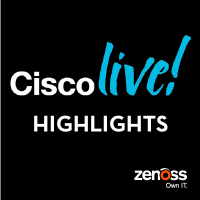 The #CLUS Event
The #CLUS Event
We just got back from Cisco Live US (#CLUS), and it really was an amazing event. Though I do feel like I spent a month in Vegas last week, the rumors of the demise of trade shows have been greatly exaggerated. Of course there is great value in digital marketing. But when you sell software to large enterprises, there is still no better way to have meaningful, face-to-face conversations with decision-makers in those organizations. Events like Cisco Live make this possible on a scale that’s not practical in other ways.
My colleague Kent Erickson wrote a blog post from the show floor on Cisco unveiling their Digital Network Architecture (DNA), which is “designed to be intuitive, can recognize intent, mitigate threats through encryption, and learn over time, unlocking opportunities.” Kent explains how this is not just hyperbole but is the true path for the future of Cisco networks.
Rather than sitting in Cisco sessions, I opted to walk the floor all week and get as much perspective as possible from the attendees, Cisco partners and other exhibitors. Here are three key things that emerged as themes from the hundreds of conversations I had.
Scale requirements just got real.
It’s so tiresome to listen to every technology vendor talk about enterprise scale. Of course, every IT professional wants the technologies that can scale (I’ve never met a customer who said, “Can you show me something with very limited scalability?”), so the vendor pandering on this front is exhausting. But here’s what’s changed — the proliferation of IP-connected systems (IoT), and of the sheer data coming from them, has reached a point where it’s breaking traditional architectures. Kent poses the real question enterprises must contemplate today: "How do we manage 100 billion network endpoints?” According to Cisco’s announcement, “Today companies are managing their networks through traditional IT processes that are not sustainable in this new age.” Technologies that will prosper in this brave new world of intelligent networks and data centers are those that can scale to jaw-dropping extremes. Fortunately, Zenoss saw this coming and over two years ago re-architected our platform for elastic scalability with a Docker-based architecture and big data back end (OpenTSDB-HBase). This isn’t just vendor speak, it’s consistently won the scalability challenge against every competitive technology.
The world is moving from monitoring to service assurance. 
For nearly as long as there have been computers, there has been some form of monitoring. Monitoring solutions originally monitored specific vendor devices, which was limiting for obvious reasons. Then solutions emerged that were (somewhat) vendor agnostic but were focused on a specific type of system — network monitoring, server monitoring, storage monitoring, etc. An improvement for sure, but still not solutions that could see the big picture. There was some advancement when solutions were offered for converged infrastructure, but this still placed a great deal of focus on hardware. Enter up-the-stack offerings for things like database monitoring and application performance monitoring (APM). Again, great improvements, but still working in silos. What Cisco realized over a year ago is that to ensure the availability of mission-critical services, a new approach was required to understand the complete anatomy of an IT service. These solutions provide what Cisco and Zenoss call IT service assurance — making sure your IT services and applications are always on. Monitoring vendors at Cisco Live were a dime a dozen. But there is ample evidence of the demise of those solutions, among which are where Cisco is placing its bets. For Cisco’s flagship Unified Computing System (UCS), the monitoring software they sell is developed by Zenoss. UCS Performance Manager (UCS PM) is actually developed by Zenoss and relabeled as Cisco software. Also, with Cisco’s technology innovation in SDN and NFV, we recently announced a partnership with Cisco to provide a unique integrated NFV Infrastructure (NFVI) solution designed to accelerate SDN deployments in service provider environments.
Automation is the precursor to artificial intelligence and machine learning.
Through all of the conversations, IT pros at every level, from every industry, were in violent agreement that going forward, automation is required for delivering quality IT support at the speed of business. In fact, I assert that automation is the stepping stone to artificial intelligence (AI) and machine learning. For their part, Cisco’s new direction is focused on automating the edge of the network and embedding analytics at a foundational level. For our part, Zenoss was ahead of the curve and leading the charge on automation of all IT operations management (ITOM) components. Given today’s requirements for massive scale and ongoing, rapid delivery of IT services, there is really no way to deliver acceptable levels of service without advanced automation capabilities. Organizations will not get to the panacea of self-healing infrastructures until they first automate IT processes through integrations. It’s no longer optional, IT departments in companies of any significant size must automate or get left behind.
One other thing I learned: The c is right next to the v on a standard keyboard — so if you type Cisco Live enough times, you will type Cisco Lice a few. Be careful with that. Also, don’t forget to check out the unique partnership between Cisco and Zenoss.









